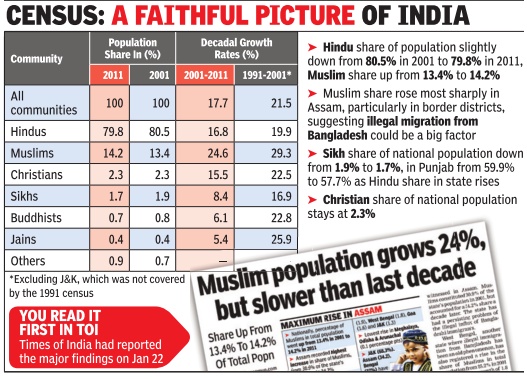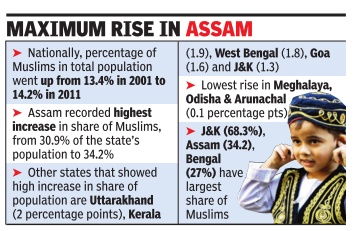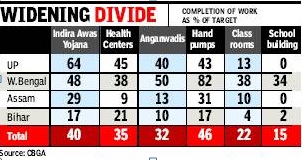Muslims: India (after 1947)
This is a collection of articles archived for the excellence of their content. |
Contents |
2007-11: Budgetary allocation
[ From the archives of the Times of India]
Subodh Varma
After the Sachar Committee report in late 2006 unequivocally showed that the Muslim community in India suffers from stark educational and employment deprivation, the UPA government announced a slew of measures targeted at mainly 66 Muslim concentration districts spread over 4 states. These measures included earmarked allocation in various schemes, multi-sectoral development plans (MSDP) scholarships etc.
How have these programmes fared? A detailed analysis done by the Center for Budget and Governance Accountabilit (CBGA), a Delhi-Based advocacy group, throws up a dismal picture. Not only has the government not allocated enough resources for the plans, even the money earmarked has not been spent. Only 64% of the Rs 8,690 crore allocated to the ministry of minority affairs were actually spent between 2007-2011. Of the Rs 3,632 crore earmarked for the multi-sectoral development programme, just 33% was actually spent. Among the four states with significant Muslim population that is shackled by under-development — West Bengal, Uttar Pradesh, Bihar and Assam — only West Bengal managed to spend about 51% of the funds allocated for the MSDP. UP spent about 33%, Bihar 31% and Assam a meager 20% of the funds. The results are obvious: key targets for setting up anganwadis, health centres, schools, handpumps etc. have not been met. For instance, in UP, 84,730 low-cost houses were to be built for below poverty line Muslim families, but only 54,045 (64%) were built. Only 5,203 handpumps were installed in Muslim localities against a target of 11,984. In Bihar, just 17% of the low cost houses, 21% of the health centers, 10% of anganwadis were built. In West Bengal and Assam too similar performance is reported, according to the CBGA analysis. While pre-matric scholarship distribution appears to have exceeded its target, in post-matric scholarship, out of a target of 2.55 lakh, only 37,000 students were actually given. Poor awareness generation among the parents, cumbersome procedure of application and lack of administrative costs being earmarked for implementation are the main reasons for this failure, says the CBGA. A new programme — the Prime Minister’s 15-Point Programme — has now been initiated to tackle problems. However, it may also flounder unless the grievous lacunae dogging earlier schemes are not corrected, says the CBGA. This includes providing special central funds to states for meeting their obligation of implementing schemes, creating institutional infrastructure at the ground level, providing for administrative costs, targeting mohallas and bastis rather than wards and districts, etc., according to the CBGA.
Level of education
[ From the archives of the Times of India]
Himanshi Dhawan TNN
Out-of-school Muslim kids rise in 12 states: Study
Delhi’s boast of being a world-class city starts to ring hollow when it comes to social indices, especially education. Studies show that the number of out-of-school Muslim children has increased from zero to 46,073 in the national capital between 2005 and 2009. Delhi is joined by 12 states, including Gujarat, Uttar Pradesh, Rajasthan, Chhattisgarh, Jharkhand and Uttarakhand, in this hall of shame. This comes at a time when the average number of out-ofschool Muslim children have come down from 9.97% in 2005 to 7.6% in 2009. A study done by International Marketing Research Bureau (IMRB) for the HRD ministry to assess the number of out-of-school children found that the estimated number between ages of 6-13 years declined from 134.6 lakh in 2005 to 81.5 lakh in 2009. Of these, the number of out-of-school Muslim children have come down from 22.5 lakh to 18.7 lakh in the same period. However, in Delhi, the number of children outof-school increased from none in 2005 to 46,073 in 2009. UP saw a sharp increase in the four year period from 7.8 lakh students out-of-school to 10.4 lakh. In Uttarakhand, the number increased from 1,161 to 35,353 while in Rajasthan, Muslim kids who were not in school increased from 26,671 to 38,360. In Arunachal Pradesh, the number of children out of school jumped from none to 357 while in Chhattisgarh the number increased from zero to 1,045. Gujarat witnessed a hike from 19,678 to 26,285 students while Jharkhand also recorded an increase from 2,798 to 18,167. Concerned over this trend and a lack of Urdu teachers, the HRD ministry has set up the National Monitoring Committee for Minorities Education and five sub-committees on girl’s education, promotion of Urdu language, mapping of educational requirements of Muslim minorities and implementation of schemes aimed for minorities.
2011
2011: 14.2% of Indians are Muslim
Muslim population grows 24%, but slower than last decade
Bharti Jain The Times of India
Share Up From 13.4% To 14.2% Of Total Popn
The 2011 census data on the population of religious groups shows a 24% rise in the Muslim population between 2001 and 2011, with the community's share of India's total population rising from 13.4% to 14.2% over the 10-year period.
While the growth rate of the Muslim population has slowed from the figure of around 29% recorded between 1991 and 2001, it is still higher than the national av erage of 18% for the decade.
The data accessed by TOI shows that the most rapid rise in the share of Muslims in the total population was witnessed in Assam. Muslims constituted 30.9% of the state's population in 2001, but accounted for a 34.2% share a decade later. The state has had a persisting problem of the illegal influx of Bangladeshi immigrants.
West Bengal, another state where illegal immigration from Bangladesh has been an old phenomenon, has also registered a rise in the share of Muslims in total population from 25.2% in 2001 to 27% in 2011, a growth of 1.8 percentage points over the 10 years, more than double the national average. Uttarakhand reported a sharp rise in the share of Muslim population from 11.9% to 13.9%, a growth of 2 percentage points against the countrywide growth of 0.8 percentage points between 2001 and 2011.
Other states with a significant rise in the share of Muslims in the total population as per the 2011 census were Kerala (from 24.7% to 26.6%), Goa (6.8% to 8.4%), Jammu & Kashmir (67% to 68.3%), Haryana (5.8% to 7%) and Delhi (11.7% to 12.9%).
The census office had compiled this data by March last year, but the UPA government held back the release, perhaps fearing political repercussions of the findings on the eve of Lok Sabha elections. Union home minister Rajnath Singh last week gave his go-ahead when Registrar General of India and Census Commissioner C Chandramouli asked whether the “sensitiive“ figures should be released.
Singh on Wednesday confirmed that the data would be made public soon.
Interestingly , Manipur was the only state to show a fall in Muslim population as a percentage of its total population (a fall of 0.4 percentage points).
The high growth of Muslim population in Assam has been intensely debated and has been a source of political confrontation. In fact, a re port prepared on the issue in 1998 by the then governor of Assam, Lt Gen (Retd) S K Sinha, had warned that illegal immigration was slowly changing the demographic profile in several districts.The Supreme Court has on more than one occasion expressed concern over the change in demography and chided the government for not stopping infiltration from Bangladesh.
2011: Rise in Muslim population
The Times of India, Aug 26 2015

Census: Kerala, U'khand saw rise in Muslim population
The share of Hindus in India's population came down a tad from 80.5% in 2001 to 79.8% in 2011, while the share of Muslims rose from 13.4% to 14.2%, Census data released on Tuesday showed.Among the other large religious communities, Christians remained at 2.3% of the population and the Jains at 0.4%, while Sikhs dropped slightly from 1.9% to 1.7% and Buddhists from 0.8% to 0.7%, the data showed. The official release confirmed what TOI had reported a good seven months earlier, on January 22. The Census has had the data ready for over a year, but had not made it public. Coming as it does in the build-up to the assembly elections in Bihar, the data could stir up even greater heat and passion than it would normally .
In line with the overall decline in the decadal growth rate of the country's population, all religious communities have seen the growth rates of their populations de DIVINE NUMBERS: P 24 clining sharply in the 20012011 period, compared to the rates in the earlier decade.The lowest decline was recorded among Hindus, from 19.9% to 16.8%.
While the national shares of different religious groups have changed only marginally, the changes are somewhat more sizeable in states like Assam, West Bengal, Kerala, Punjab, Uttarakhand and some states in the northeast.
In Assam, for instance, the share of Muslims in the total population has increased from 30.9% in 2001 to 34.2% in 2011. That illegal migration from Bangladesh is playing a part in this is evident from the fact that nine of the state's 27 districts are now Muslim-majority compared to six of 23 earlier. All of these districts are in the areas bordering Bangladesh.
In West Bengal too, the Muslims in 2011 constituted 27% of the population against 25.2% a decade earlier, though in this case the border districts do not show a no ticeable jump in minority population shares compared to 2001. Uttar Dinajpur has joined Malda and Murshidabad in the list of districts where Muslims outnumber Hindus, though at 49.9% they are just short of being an outright majority . Kerala and Uttarakhand have also registered significant increases in the share of the Muslims in their population, while in many other states there is a small increase in the share of Muslims.
In Punjab, on the other hand, the share of Hindus has increased from 36.9% to 38.5%, with the share of Sikhs dropping from 59.9% to 57.7%. The Sikhs have also declined from 16.1% to 13.1% of Chandigarh's population and from 4.0% to 3.4% of Delhi. The Hindu share of population has also risen by one percentage point in Nagaland, and more marginally in Karnataka and Goa and in some of the union territories like.
In Arunachal Pradesh and Manipur, the Christians formed a significantly larger share of the population in 2011 than they did in 2001. In Arunachal, their share rose from 18.7% to 30.3%, while in Manipur it rose from 34% to 41.3%, which is just a little lower than the 41.4% share of population that Hindus have in the state.
Muslims can not be SC
Muslims not entitled to SC status, says HC
The Punjab and Haryana high court on Tuesday ruled Muslims were not entitled to benefits reserved for the Scheduled Castes (SC) while cancelling the 2012 election of Congress MLA Mohammad Sadiq from Punjab's reserved Bhadaur constituency.
Justice N K Sanghi said Sadiq was not qualified to contest from the SC reserved seat as he is a Muslim and had failed to prove he had converted to Sikhism.
Sadiq had claimed before the court he was an SC Muslim before he had converted to Sikhism. He had pleaded he should be considered SC Sikh after his conversion.
The high court order came on the petition of ex-IAS officer and ruling Shiromani Akali Dal's Darbara Singh Guru, who had lost the election to Sadiq by nearly 7,000 votes.
"...the court has found that since he is a Muslim, he cannot get benefits of SCs. The reverse has also been clarified thorough this case," said Guru's lawyer, Satya Pal Jain.
Jain said this is the first judicial pronouncement on who can be considered an SC. "The Constitution (Scheduled Castes) Order, 1950, states that only Hindus, Sikhs and Buddhists can avail benefits as SCs. This is because the caste system is prevalent only in these religions."
Sadiq had told the court his mother, Prasanni Devi, was a Muslim who never followed Islam and that he had "always professed Sikhism and was an SC".
He claimed he belonged to the Doom community, which the Punjab government had notified as SC.
Sadiq, a well-known Punjabi folk singer, claimed he had converted to Sikhism in 2007, but Jain contested this stating he had not follow the prescribed procedure, including notifying the Shiromani Gurdwara Prabandhak Committee.
Guru, a former principal secretary to chief minister Parkash Singh Badal, had accused Sadiq of misleading the Election Commission. He contended Sadiq was still a Muslim.
Guru had filed his petition on March 30, 2012 and the high court had reserved its judgment in January. Barnala-resident Badal Singh had earlier moved the Punjab Scheduled Caste Commission before the assembly polls demanding cancellation of Sadiq's SC certificate that Ludhiana administration had issued in 2006.
Kerala: Flowers for dieties farmed by Muslims
The Times of India, Jun 07 2015
Tp Nijeesh
Malappuram
Flowers for Kerala deities bloom in Muslim farms
It is known to very few devotees that the lotus blooms used in all major temples across the state including Guruvayur Sri Krishna Temple, Sabarimala, Kodungalloor Bhagavathy Temple, Paramekkavu Bhagavathi Temple, Thriprayar Sri Rama Temple and Parshinikkaadavu Muthappan Temple are all farmed by Muslim families.
On an average, the village collects and distributes around 20,000 blooms every day. “Our business has thrived only because of the blessings of the deities and the revenue from temples,“ says a supplier flowers to Guruvayur and Paramekkavu temple in Thrissur from his 85-acre farm.
The flowers are handed over to members of the Warrier community , who handle floral decorations in temples.“The Muslim families of Thirunavaya have maintained a good relationship with all temples,“ says Unni Varrier of Kadambuzha Bhagavathy Temple Devaswom.
But lotus farming is becoming increasingly difficult for farmers. “Water hyacinths pose a major issue. Also, water levels have been receding over the years. Sometimes it is difficult to continue farming, especially with nil government aid,“ he says.
2014-16
The Times of India, Mar 14, 2016
Mohammed Wajihuddin
During 2014-15, 2015-16; Muslims got only 2% of 6 PSBs' priority sector loans: RTI
If there were any doubts about low lending by banks to Muslims - one of the reasons for the community's financial exclusion - an RTI disclosure conclusively lays them to rest. Answers received through Right To Information applications to half-a- dozen banks by Mumbai-based activist M A Khalid show that of all priority sector loans, Muslims got a little over 2% in both 2014-15 and till September 30 in 2015-16. The revelation may strengthen the feeling within the community that it is getting further marginalised under the NDA dispensation. Although there are no specific guidelines about granting loans to Muslims, the banks agreed that 15% of the total priority sector loans should go to the minority community. Muslims constituted 14.2% or 17.22 crore (as per the 2011 census) of India's population of 121.09 crore and scholars and community representatives feel their share in bank loans should be much higher. Among the six public sector banks - Punjab & Sind Bank, Allahabad Bank, Corporation Bank, Bank of Maharashtra, Vijaya Bank and Andhra Bank - from which Khalid got information, only Allahabad Bank showed an encouraging trend. It said the share of Muslims in priority sector credit of the bank was 7.07% as on March 31, 2015, which increased to 7.19% on September 30. The bank showing the lowest disbursal of loans to Muslims was Corporation Bank - 1.90% (as on March 31, 2015) and 1.95% (as on September 30, 2015).
"The data clearly shows no extra efforts are being made to increase Muslims' share in loans for minorities under the priority sector. It exposes the hollowness of PM Narendra Modi's 'sabka saath sabka vikas' slogan," said Khalid. TOI sent email queries seeking clarifications to Punjab & Sind Bank, Allahabad Bank, Bank of Maharashtra and Andhra Bank. None replied. However, an official from BoM said over phone that "we are increasing our presence in Muslim pockets by opening more branches".
Dr Abdul Shaban, deputy director, Tata Institute of Social Sciences, said: "In a survey done a couple of years ago it was found that one of the reasons for Muslims' financial exclusion is the negligible presence of banks in Muslim-concentrated areas." The Sachar Report had observed that many Muslim-concentrated areas were marked by some banks as 'negative' or 'red' zones where they were reluctant to give loans. Since the panel also found that many Muslims are self-employed, an increase in loans to the community will help them become financially strong.
See also
Muslims in central India: 1916 <>
…and countless other articles about Muslim communities by clicking the Communities link below or by entering a word or phrase in the Search rectangle on the top right of this page.


